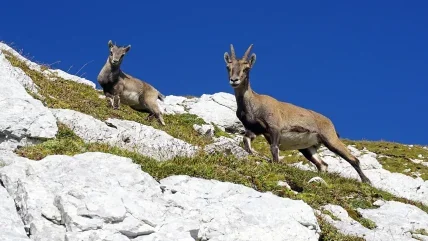
Alpine Ibex are big mountain goat-like herbivores inhabiting the highest peaks of the Alps in Europe. The silhouette of their horns standing out against the sky became an unmistakable symbol. For a long time Ibex have been an emblematic species in the Alpine regions. In the past they were intensively hunted both for meat consumption and for supposed, but never demonstrated, curative properties of their horns and other body parts. The excessive hunting pressure brought the species almost to complete extinction in the 19th century with no more than a hundred individuals surviving in a small area of the Western Alps. However thanks to the institution of a hunting reserve first, and then of the Gran Paradiso National Park, the last individuals survived and were used for reintroduction on the entire Alpine arc.
Nowadays Ibex are again spread across the Alps and estimates suggest that there are 50,000 individuals. Now a protected species they are an attraction for many visitors and tourists that frequent the Alps. The rescue of Alpine ibex is indeed one of the most successful stories of active protection of nature in the world.
Climbing ability
Ibex are herbivores and spend most of the time in pastureland eating grass to gain fat reserves in order to survive the harsh conditions of Alpine winters when they can't find food. Males and females are easy to recognise as they are very different in size and shape: adult males can weight more than 100kg at the end of summer and have long horns up to 1m in length, while females rarely exceed 50kg and have small and short horns. Their behaviour is also different and they live in separate areas for most of the year joining each other only for the breeding season in December-January.
Ibex are undoubtedly famous for agonistic interactions between males when they loudly clash their big horns to establish hierarchies. However, one of the most incredible skills of this animals is their climbing ability. Every hiker that has walked through the Alps knows how agile these animals are, whose only anti-predatory strategy is to climb a cliff moving out of reach for any predator.
The knowledge of this ability has recently crossed the borders of the Alps landing on the worldwide web and becoming almost viral. This was thanks to a Youtube video showing female ibex climbing the almost vertical wall of the Cingino dam at 20145masl in the Piemonte region of Italy. It has also recently been filmed for a TV documentary in the UK.
Cingino is not the only dam climbed by ibex. This behaviour has also been observed at other dams in Italy, for example:
- Barbellino dam in Lombardy – 1868masl: concrete wall, 64m high, straight slope of 123% from the ground to 31m, then 157% for 22m, and then almost vertical.
- Lago della Rossa dam in Valli di Lanzo, Piemonte – 2716masl: brickwork wall, 24m high, straight slope of 161% from the ground to 19m, then almost vertical. [Biancardi and Binetti 2014].
The reason why Ibex climb dams is rather easy: they are looking for salt. The Ibex’s herbivorous diet is lacking in salt, especially calcium salts. Farmers provide salt for almost all herbivore livestock but in the wild animals have to find salts by themselves.
In spring, the time when salt requirements is highest, it's not rare to observe Ibex “eating” the ground seeking for mineral salts released by rocks and sometimes they are also observed licking the street attracted by anti-frosting salts.
Dam walls, composed of stones and concrete, seem to be a precious source of salts for these extraordinary animals that are able to exploit all available resources. Despite little being known about the exact composition of the salt that attracts ibex to the dam walls, researchers think that they are attracted by ettringite (or Candlot salt). Ettringite can develop in the concrete that compose dam walls due to both chemical or thermic stress experienced by the concrete itself. Since ettringite is a salt and partially soluble in water, water can dissolve it making it available on the dam surface. Despite limited study into this topic, damage to dam walls has not been reported as a consequence of Ibex activity.
Ibex are among the only animals able to exploit this salt source. Compared with other ungulates, Ibex are extraordinary climbers, perfectly adapted to steep slopes thanks to the particular shape of their cloven hooves. Ibex hooves are composed of two toes that can move independently; the lower part of each toe is made by a strong external and a soft internal part that allow Ibex to handhold on extremely narrow surfaces. However, not even all Ibex are able to climb the almost vertical dam walls. Large males have not been observed in this behaviour probably as their body mass, their barycenter and the encumbrance of their large horns do not allow them to stand on the walls with the angle needed to keep balance.
The unbelievable images of Ibex climbing dams are now famous all over the world thanks to their spread on the internet. Hopefully these images will also help to disseminate knowledge about this species and awareness of its interesting history, and on how human activity can influence, positively or negatively, the environment.
As a final thought, the pictures of Ibex climbing dams are also an image of how nature tries to survive and coexist with human activity. Indeed, despite their undeniable importance as a clean power source, dams have a strong impact on the landscape and the environment of mountainous areas. Ibex have however learned to take a little advantage of using them as a salt source (and maybe also having some fun!).






